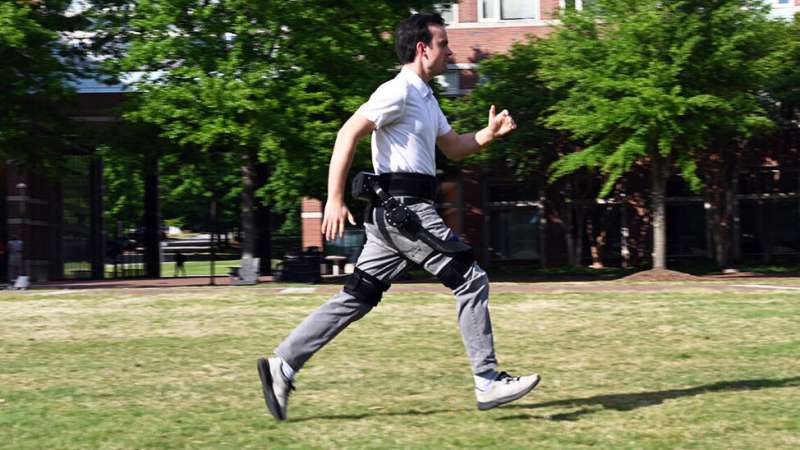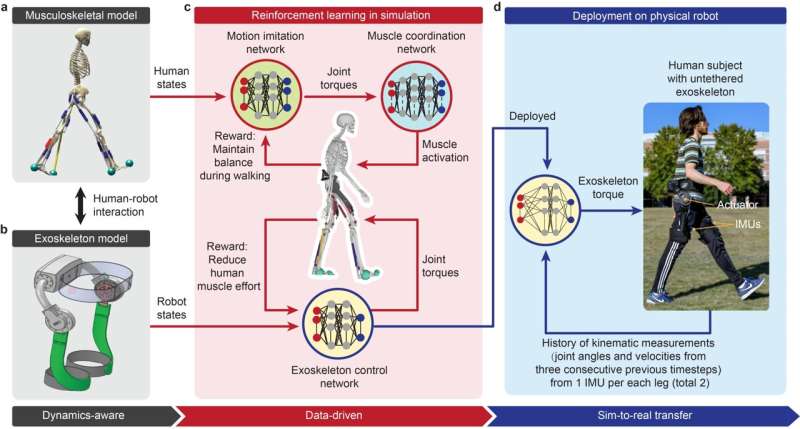This article has been reviewed according to Science X's editorial process and policies. Editors have highlighted the following attributes while ensuring the content's credibility:
fact-checked
peer-reviewed publication
proofread
AI strategy may promise more widespread use of portable, robotic exoskeletons—on Earth and in space

Safer, more efficient movements for factory workers and astronauts, and improved mobility for people with disabilities could someday become a more widespread reality, thanks to research published June 12 in the journal Nature.
Called "exoskeletons," wearable robotic frameworks for the human body promise easier movement, but technological hurdles have limited their broader application, explained Dr. Shuzhen Luo of Embry-Riddle Aeronautical University—first author of the paper, with corresponding author Dr. Hao Su of North Carolina State University (NC State) and other colleagues.
To date, exoskeletons must be pre-programmed for specific activities and individuals, based on lengthy, costly, labor-intensive tests with human subjects, Luo noted.
Now, researchers have described a super smart or "learned" controller that leverages data-intensive artificial intelligence (AI) and computer simulations to train portable, robotic exoskeletons.
"This new controller provides smooth, continuous torque assistance for walking, running, or climbing stairs without the need for any human-involved testing," Luo reported. "With only one run on a graphics processing unit, we can train a control law or 'policy,' in simulation, so that the controller can effectively assist all three activities and various individuals."
Driven by three interconnected, multi-layered neural networks, the controller learns as it goes—evolving through "millions of epochs of musculoskeletal simulation to improve human mobility," explained Dr. Luo, assistant professor of Mechanical Engineering at Embry-Riddle's Daytona Beach, Florida, campus.
The experiment-free, "learning-in-simulation" framework, deployed on a custom hip exoskeleton, generated what appears to be the highest metabolic rate reductions of portable hip exoskeletons to date—with an average of 24.3%, 13.1% and 15.4% reduced energy expenditure by wearers, for walking, running and stair-climbing, respectively.
These energy reduction rates were calculated by comparing the performance of human subjects both with and without the robotic exoskeleton, Su of NC State explained.

"That means it's a true measure of how much energy the exoskeleton is saving," said Su, associate professor of Mechanical and Aerospace Engineering. "This work is essentially making science fiction reality—allowing people to burn less energy while conducting a variety of tasks."
Bridging the simulation-to-reality gap
The approach is believed to be the first to demonstrate the feasibility of developing controllers, in simulation, that bridge the so-called simulation-to-reality, or "sim2real gap" while significantly improving human performance.
"Previous achievements in reinforcement learning have tended to focus primarily on simulation and board games," Luo said, "whereas we proposed a new method—namely, a dynamic-aware, data-driven reinforcement learning way to train and control wearable robots to directly benefit humans."
The framework "may offer a generalizable and scalable strategy for the rapid, widespread deployment of a variety of assistive robots for both able-bodied and mobility-impaired individuals," added Su.
Overcoming technological obstacles
As noted, exoskeletons have traditionally required handcrafted control laws based on time-consuming human tests to handle each activity and account for differences in individual gaits, researchers explained in the Nature paper. A learning-in-simulation approach suggested a possible solution to those obstacles.
The resulting "dynamics-aware, data-driven reinforcement learning approach" dramatically expedites the development of exoskeletons for real-world adoption, Luo said.
The closed-loop simulation incorporates both exoskeleton controller and physics models of musculoskeletal dynamics, human-robot interaction and muscle reactions to generate efficient and realistic data. In this way, a control policy can evolve or learn in simulation.
"Our method provides a foundation for turnkey solutions in controller development for wearable robots," Luo said.
Future research will focus on unique gaits, for walking, running or stair climbing, to help people who have disabilities such as stroke, osteoarthritis and cerebral palsy as well as those with amputations.
More information: Experiment-free optimization of exoskeleton assistance via learning in simulation, Nature (2024). DOI: 10.1038/s41586-024-07382-4. www.nature.com/articles/s41586-024-07382-4


















